1 Introduction In stone drilling, various complex tribological phenomena occur at the contact interface due to the relatively high speed movement between the diamond bit and the stone. The friction between the diamond bit and the stone, due to the poor thermal conductivity of the stone, most of the heat is transferred to the diamond head, which causes the surface temperature of the diamond bit to rise, resulting in diamond graphitization, reduced diamond cutting ability, and thermal fatigue of the bit body. The strength and rigidity are reduced, the noise is increased when the stone is processed, the vibration is intensified, the life of the drill bit is lowered, and the diamond cutter head is detached in severe cases, causing damage to the operator, and also affecting the processing quality and processing efficiency. Studying the influence of diamond bit drilling parameters on its surface temperature, finding out the relationship and law affecting surface temperature factors, and determining reasonable processing parameters, it is beneficial to improve the service life of diamond bit and reduce processing cost and improve processing quality. 2 Experimental conditions The diamond cutter head is made of Cu-based metal powder with a diamond particle size of 60-80 mesh. It is pressed and formed by sintering molding, and the cutter head is welded on a high-speed steel cylinder. The diamond drill has a diameter of φ37 mm, a height of 5.6 mm, a width of 2 mm, a base diameter of φ35.6 mm, and a height of 45 mm. The processing equipment adopts XK5032C CNC milling machine. The equipment realizes automatic feeding in three directions of X-axis, Y-axis and Z-axis. The cooling method of the spindle is water-cooled. The temperature generated on the surface of the tool is measured by an infrared temperature measuring instrument, and the measurement temperature ranges from -50 to 650 °C. Direct measurement at room temperature l2 °C. The stone is made of marble, sandstone and granite. This experiment mainly studies the influence of parameters such as spindle speed, feed rate and stone performance on the surface temperature of diamond bit. The experiment was carried out under dry cutting conditions, and the processing state is shown in Fig. 1. 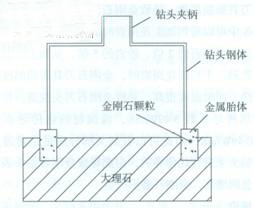 Fig.1 Schematic diagram of diamond bit processing stoneFig.3 Analysis of results 3.1 Effect of feed rate on temperature
Fig.1 Schematic diagram of diamond bit processing stoneFig.3 Analysis of results 3.1 Effect of feed rate on temperature 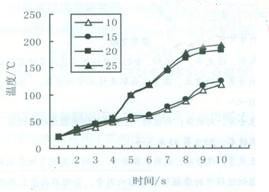 Figure 2 Feed rate and diamond bit surface temperature relationship
Figure 2 Feed rate and diamond bit surface temperature relationship 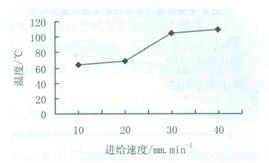 Fig. 3 Relationship between feed rate and surface temperature of diamond bit When diamond bit is used to process stone, there are many parameters affecting the surface temperature of the bit, including diamond properties, bond properties, stone physical and mechanical properties, processing parameters, and cooling parameters. This experiment investigated the effects of processing parameters and stone properties on the surface temperature of diamond bits. Figure 2 is a plot of the pre-drilling time of the bit surface temperature during drilling of marble at a spindle speed of 300 r/min and feed rates of 10 mm/min, 15 mm/min, 20 mm/min, and 25 mm/min, respectively. It can be seen from Fig. 2 that under the four feed rate conditions, the surface temperature of the diamond bit increases with the increase of the processing time. In the initial stage of processing, the temperature increase is relatively slow, and when the processing time exceeds 4 s, the temperature increases sharply. When the processing time reaches 10s, the surface temperature of the diamond bit is 5 times of the initial. Figure 3 is a graph showing the relationship between feed rate and temperature when processing marble. It can be seen from the figure that the temperature rises slowly at the feed rate of l0~20mm/min. When the feed rate is 20~30mm/min, the temperature rise is most obvious. In this interval, the heat generated by the drill stone is the most. Due to the large friction between the diamond bit and the stone surface during the drilling process, the surface temperature of the diamond bit increases. Since the thermal conductivity of marble is very low, and the thermal conductivity of the tool is very high, a large part of the heat is transferred to the diamond bit, resulting in an increase in the surface temperature of the diamond bit. As the feed rate increases, the cutting surface is increased per unit time, the number of times the tool contacts the stone increases, and the surface temperature increases. 3.2 Influence of spindle revolution on temperature
Fig. 3 Relationship between feed rate and surface temperature of diamond bit When diamond bit is used to process stone, there are many parameters affecting the surface temperature of the bit, including diamond properties, bond properties, stone physical and mechanical properties, processing parameters, and cooling parameters. This experiment investigated the effects of processing parameters and stone properties on the surface temperature of diamond bits. Figure 2 is a plot of the pre-drilling time of the bit surface temperature during drilling of marble at a spindle speed of 300 r/min and feed rates of 10 mm/min, 15 mm/min, 20 mm/min, and 25 mm/min, respectively. It can be seen from Fig. 2 that under the four feed rate conditions, the surface temperature of the diamond bit increases with the increase of the processing time. In the initial stage of processing, the temperature increase is relatively slow, and when the processing time exceeds 4 s, the temperature increases sharply. When the processing time reaches 10s, the surface temperature of the diamond bit is 5 times of the initial. Figure 3 is a graph showing the relationship between feed rate and temperature when processing marble. It can be seen from the figure that the temperature rises slowly at the feed rate of l0~20mm/min. When the feed rate is 20~30mm/min, the temperature rise is most obvious. In this interval, the heat generated by the drill stone is the most. Due to the large friction between the diamond bit and the stone surface during the drilling process, the surface temperature of the diamond bit increases. Since the thermal conductivity of marble is very low, and the thermal conductivity of the tool is very high, a large part of the heat is transferred to the diamond bit, resulting in an increase in the surface temperature of the diamond bit. As the feed rate increases, the cutting surface is increased per unit time, the number of times the tool contacts the stone increases, and the surface temperature increases. 3.2 Influence of spindle revolution on temperature  Figure 4 Relationship between spindle speed and surface temperature of diamond bit
Figure 4 Relationship between spindle speed and surface temperature of diamond bit 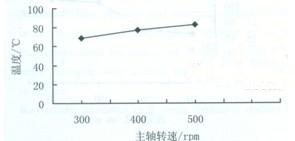 Figure 5 Relationship between spindle speed and diamond bit surface temperature Figure 4 shows the relationship between the surface temperature of the diamond bit and the drilling time when the feed rate is 15mm/min and the spindle speed is 300rpm, 400rpm, 500rpm, respectively. Overall, the temperature rises linearly with time. In addition, it can be seen from Fig. 5 that the temperature increases as the spindle speed increases. However, the temperature rise is not obvious. When the number of spindle revolutions reaches 500r/min, the maximum temperature is 143 °C. The spindle speed increases. The number of rubbing of the diamond particles and the stone in the unit time increases, and the contact time is long, thereby causing the surface temperature to increase. 3.3 Influence of stone performance on surface temperature Figure 5 shows the spindle speed of 300 rpm and the feed rate of 15 mm/min. Processing the average surface temperature of different stone diamond drill bits. It can be seen from Fig. 5 that the diamond surface temperature is the largest when drilling granite, reaching l50 °C, while the surface temperature is the lowest when processing sandstone is 30 °C; the temperature when processing marble is 70 °C. According to the properties of stone, the density of granite is 2.5-2.7kg/cm3, the compressive strength is 120-250MPa, the density of marble is 2.5-2.7 kg/cm3, the compressive strength is 47-120MPa, and the density of sandstone It is 2.2 to 2.5 kg/cm3 and has a compressive strength of 47 to 120 MPa. The density of the three types of stone is basically the same, but the compressive strength of granite is much greater than that of marble and sandstone, almost twice that of marble and sandstone. The strength of the stone increases, the cutting force increases, and the diamond tool wears severely, resulting in an increase in the surface temperature of the diamond bit. It can be seen from Fig. 5 that the surface temperature of the diamond cutter when processing granite is twice that of the processed marble and five times that of the sandstone. It can be seen from the processing experiment that when the granite is dry-cut, the surface temperature of the diamond cutter rises rapidly, and the temperature is high, causing the diamond cutter head to fall off. The thermal conductivity of granite is 3.49W/mK, and the thermal conductivity of copper is 370.49W/mK. It can be seen that most of the heat is transferred by the diamond drill bit, which leads to a sharp increase in the surface temperature of the diamond drill bit. Diamond wear is severe.
Figure 5 Relationship between spindle speed and diamond bit surface temperature Figure 4 shows the relationship between the surface temperature of the diamond bit and the drilling time when the feed rate is 15mm/min and the spindle speed is 300rpm, 400rpm, 500rpm, respectively. Overall, the temperature rises linearly with time. In addition, it can be seen from Fig. 5 that the temperature increases as the spindle speed increases. However, the temperature rise is not obvious. When the number of spindle revolutions reaches 500r/min, the maximum temperature is 143 °C. The spindle speed increases. The number of rubbing of the diamond particles and the stone in the unit time increases, and the contact time is long, thereby causing the surface temperature to increase. 3.3 Influence of stone performance on surface temperature Figure 5 shows the spindle speed of 300 rpm and the feed rate of 15 mm/min. Processing the average surface temperature of different stone diamond drill bits. It can be seen from Fig. 5 that the diamond surface temperature is the largest when drilling granite, reaching l50 °C, while the surface temperature is the lowest when processing sandstone is 30 °C; the temperature when processing marble is 70 °C. According to the properties of stone, the density of granite is 2.5-2.7kg/cm3, the compressive strength is 120-250MPa, the density of marble is 2.5-2.7 kg/cm3, the compressive strength is 47-120MPa, and the density of sandstone It is 2.2 to 2.5 kg/cm3 and has a compressive strength of 47 to 120 MPa. The density of the three types of stone is basically the same, but the compressive strength of granite is much greater than that of marble and sandstone, almost twice that of marble and sandstone. The strength of the stone increases, the cutting force increases, and the diamond tool wears severely, resulting in an increase in the surface temperature of the diamond bit. It can be seen from Fig. 5 that the surface temperature of the diamond cutter when processing granite is twice that of the processed marble and five times that of the sandstone. It can be seen from the processing experiment that when the granite is dry-cut, the surface temperature of the diamond cutter rises rapidly, and the temperature is high, causing the diamond cutter head to fall off. The thermal conductivity of granite is 3.49W/mK, and the thermal conductivity of copper is 370.49W/mK. It can be seen that most of the heat is transferred by the diamond drill bit, which leads to a sharp increase in the surface temperature of the diamond drill bit. Diamond wear is severe. 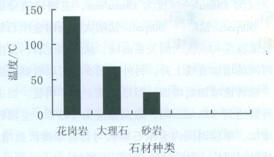 Figure 6 Stone type and diamond bit surface temperature 4 Conclusion When using diamond bit to process stone, the machining parameters such as spindle speed and drilling speed have a great influence on the tool surface temperature. The tool surface temperature increases as the spindle speed and feed rate increase. The surface temperature of the diamond bit increases as the drilling time increases, and is proportional to the drilling time. The performance of the stone has a great influence on the surface temperature of the diamond bit. When drilling granite under the same conditions, the surface temperature of the drill bit is twice that of marble and five times that of sandstone. Coolant should be used for dry drilling to prevent diamond bit wear. Brazing or laser welding should be used for sintered diamond. It can ensure that the weld is resistant to high temperature and the diamond cutter head will not fall off earlier.
Figure 6 Stone type and diamond bit surface temperature 4 Conclusion When using diamond bit to process stone, the machining parameters such as spindle speed and drilling speed have a great influence on the tool surface temperature. The tool surface temperature increases as the spindle speed and feed rate increase. The surface temperature of the diamond bit increases as the drilling time increases, and is proportional to the drilling time. The performance of the stone has a great influence on the surface temperature of the diamond bit. When drilling granite under the same conditions, the surface temperature of the drill bit is twice that of marble and five times that of sandstone. Coolant should be used for dry drilling to prevent diamond bit wear. Brazing or laser welding should be used for sintered diamond. It can ensure that the weld is resistant to high temperature and the diamond cutter head will not fall off earlier.
 Fig.1 Schematic diagram of diamond bit processing stoneFig.3 Analysis of results 3.1 Effect of feed rate on temperature
Fig.1 Schematic diagram of diamond bit processing stoneFig.3 Analysis of results 3.1 Effect of feed rate on temperature  Figure 2 Feed rate and diamond bit surface temperature relationship
Figure 2 Feed rate and diamond bit surface temperature relationship  Fig. 3 Relationship between feed rate and surface temperature of diamond bit When diamond bit is used to process stone, there are many parameters affecting the surface temperature of the bit, including diamond properties, bond properties, stone physical and mechanical properties, processing parameters, and cooling parameters. This experiment investigated the effects of processing parameters and stone properties on the surface temperature of diamond bits. Figure 2 is a plot of the pre-drilling time of the bit surface temperature during drilling of marble at a spindle speed of 300 r/min and feed rates of 10 mm/min, 15 mm/min, 20 mm/min, and 25 mm/min, respectively. It can be seen from Fig. 2 that under the four feed rate conditions, the surface temperature of the diamond bit increases with the increase of the processing time. In the initial stage of processing, the temperature increase is relatively slow, and when the processing time exceeds 4 s, the temperature increases sharply. When the processing time reaches 10s, the surface temperature of the diamond bit is 5 times of the initial. Figure 3 is a graph showing the relationship between feed rate and temperature when processing marble. It can be seen from the figure that the temperature rises slowly at the feed rate of l0~20mm/min. When the feed rate is 20~30mm/min, the temperature rise is most obvious. In this interval, the heat generated by the drill stone is the most. Due to the large friction between the diamond bit and the stone surface during the drilling process, the surface temperature of the diamond bit increases. Since the thermal conductivity of marble is very low, and the thermal conductivity of the tool is very high, a large part of the heat is transferred to the diamond bit, resulting in an increase in the surface temperature of the diamond bit. As the feed rate increases, the cutting surface is increased per unit time, the number of times the tool contacts the stone increases, and the surface temperature increases. 3.2 Influence of spindle revolution on temperature
Fig. 3 Relationship between feed rate and surface temperature of diamond bit When diamond bit is used to process stone, there are many parameters affecting the surface temperature of the bit, including diamond properties, bond properties, stone physical and mechanical properties, processing parameters, and cooling parameters. This experiment investigated the effects of processing parameters and stone properties on the surface temperature of diamond bits. Figure 2 is a plot of the pre-drilling time of the bit surface temperature during drilling of marble at a spindle speed of 300 r/min and feed rates of 10 mm/min, 15 mm/min, 20 mm/min, and 25 mm/min, respectively. It can be seen from Fig. 2 that under the four feed rate conditions, the surface temperature of the diamond bit increases with the increase of the processing time. In the initial stage of processing, the temperature increase is relatively slow, and when the processing time exceeds 4 s, the temperature increases sharply. When the processing time reaches 10s, the surface temperature of the diamond bit is 5 times of the initial. Figure 3 is a graph showing the relationship between feed rate and temperature when processing marble. It can be seen from the figure that the temperature rises slowly at the feed rate of l0~20mm/min. When the feed rate is 20~30mm/min, the temperature rise is most obvious. In this interval, the heat generated by the drill stone is the most. Due to the large friction between the diamond bit and the stone surface during the drilling process, the surface temperature of the diamond bit increases. Since the thermal conductivity of marble is very low, and the thermal conductivity of the tool is very high, a large part of the heat is transferred to the diamond bit, resulting in an increase in the surface temperature of the diamond bit. As the feed rate increases, the cutting surface is increased per unit time, the number of times the tool contacts the stone increases, and the surface temperature increases. 3.2 Influence of spindle revolution on temperature  Figure 4 Relationship between spindle speed and surface temperature of diamond bit
Figure 4 Relationship between spindle speed and surface temperature of diamond bit  Figure 5 Relationship between spindle speed and diamond bit surface temperature Figure 4 shows the relationship between the surface temperature of the diamond bit and the drilling time when the feed rate is 15mm/min and the spindle speed is 300rpm, 400rpm, 500rpm, respectively. Overall, the temperature rises linearly with time. In addition, it can be seen from Fig. 5 that the temperature increases as the spindle speed increases. However, the temperature rise is not obvious. When the number of spindle revolutions reaches 500r/min, the maximum temperature is 143 °C. The spindle speed increases. The number of rubbing of the diamond particles and the stone in the unit time increases, and the contact time is long, thereby causing the surface temperature to increase. 3.3 Influence of stone performance on surface temperature Figure 5 shows the spindle speed of 300 rpm and the feed rate of 15 mm/min. Processing the average surface temperature of different stone diamond drill bits. It can be seen from Fig. 5 that the diamond surface temperature is the largest when drilling granite, reaching l50 °C, while the surface temperature is the lowest when processing sandstone is 30 °C; the temperature when processing marble is 70 °C. According to the properties of stone, the density of granite is 2.5-2.7kg/cm3, the compressive strength is 120-250MPa, the density of marble is 2.5-2.7 kg/cm3, the compressive strength is 47-120MPa, and the density of sandstone It is 2.2 to 2.5 kg/cm3 and has a compressive strength of 47 to 120 MPa. The density of the three types of stone is basically the same, but the compressive strength of granite is much greater than that of marble and sandstone, almost twice that of marble and sandstone. The strength of the stone increases, the cutting force increases, and the diamond tool wears severely, resulting in an increase in the surface temperature of the diamond bit. It can be seen from Fig. 5 that the surface temperature of the diamond cutter when processing granite is twice that of the processed marble and five times that of the sandstone. It can be seen from the processing experiment that when the granite is dry-cut, the surface temperature of the diamond cutter rises rapidly, and the temperature is high, causing the diamond cutter head to fall off. The thermal conductivity of granite is 3.49W/mK, and the thermal conductivity of copper is 370.49W/mK. It can be seen that most of the heat is transferred by the diamond drill bit, which leads to a sharp increase in the surface temperature of the diamond drill bit. Diamond wear is severe.
Figure 5 Relationship between spindle speed and diamond bit surface temperature Figure 4 shows the relationship between the surface temperature of the diamond bit and the drilling time when the feed rate is 15mm/min and the spindle speed is 300rpm, 400rpm, 500rpm, respectively. Overall, the temperature rises linearly with time. In addition, it can be seen from Fig. 5 that the temperature increases as the spindle speed increases. However, the temperature rise is not obvious. When the number of spindle revolutions reaches 500r/min, the maximum temperature is 143 °C. The spindle speed increases. The number of rubbing of the diamond particles and the stone in the unit time increases, and the contact time is long, thereby causing the surface temperature to increase. 3.3 Influence of stone performance on surface temperature Figure 5 shows the spindle speed of 300 rpm and the feed rate of 15 mm/min. Processing the average surface temperature of different stone diamond drill bits. It can be seen from Fig. 5 that the diamond surface temperature is the largest when drilling granite, reaching l50 °C, while the surface temperature is the lowest when processing sandstone is 30 °C; the temperature when processing marble is 70 °C. According to the properties of stone, the density of granite is 2.5-2.7kg/cm3, the compressive strength is 120-250MPa, the density of marble is 2.5-2.7 kg/cm3, the compressive strength is 47-120MPa, and the density of sandstone It is 2.2 to 2.5 kg/cm3 and has a compressive strength of 47 to 120 MPa. The density of the three types of stone is basically the same, but the compressive strength of granite is much greater than that of marble and sandstone, almost twice that of marble and sandstone. The strength of the stone increases, the cutting force increases, and the diamond tool wears severely, resulting in an increase in the surface temperature of the diamond bit. It can be seen from Fig. 5 that the surface temperature of the diamond cutter when processing granite is twice that of the processed marble and five times that of the sandstone. It can be seen from the processing experiment that when the granite is dry-cut, the surface temperature of the diamond cutter rises rapidly, and the temperature is high, causing the diamond cutter head to fall off. The thermal conductivity of granite is 3.49W/mK, and the thermal conductivity of copper is 370.49W/mK. It can be seen that most of the heat is transferred by the diamond drill bit, which leads to a sharp increase in the surface temperature of the diamond drill bit. Diamond wear is severe.  Figure 6 Stone type and diamond bit surface temperature 4 Conclusion When using diamond bit to process stone, the machining parameters such as spindle speed and drilling speed have a great influence on the tool surface temperature. The tool surface temperature increases as the spindle speed and feed rate increase. The surface temperature of the diamond bit increases as the drilling time increases, and is proportional to the drilling time. The performance of the stone has a great influence on the surface temperature of the diamond bit. When drilling granite under the same conditions, the surface temperature of the drill bit is twice that of marble and five times that of sandstone. Coolant should be used for dry drilling to prevent diamond bit wear. Brazing or laser welding should be used for sintered diamond. It can ensure that the weld is resistant to high temperature and the diamond cutter head will not fall off earlier.
Figure 6 Stone type and diamond bit surface temperature 4 Conclusion When using diamond bit to process stone, the machining parameters such as spindle speed and drilling speed have a great influence on the tool surface temperature. The tool surface temperature increases as the spindle speed and feed rate increase. The surface temperature of the diamond bit increases as the drilling time increases, and is proportional to the drilling time. The performance of the stone has a great influence on the surface temperature of the diamond bit. When drilling granite under the same conditions, the surface temperature of the drill bit is twice that of marble and five times that of sandstone. Coolant should be used for dry drilling to prevent diamond bit wear. Brazing or laser welding should be used for sintered diamond. It can ensure that the weld is resistant to high temperature and the diamond cutter head will not fall off earlier. Single Eyelet,Eyelets Prym,Prym Grommets,Washer Eyelet
NINGBO ZONGLAN MECHANICAL AND ELECTRICAL EQUIPMENT MANUFACTURE CO., LTD , https://www.zonglaneyelet.com